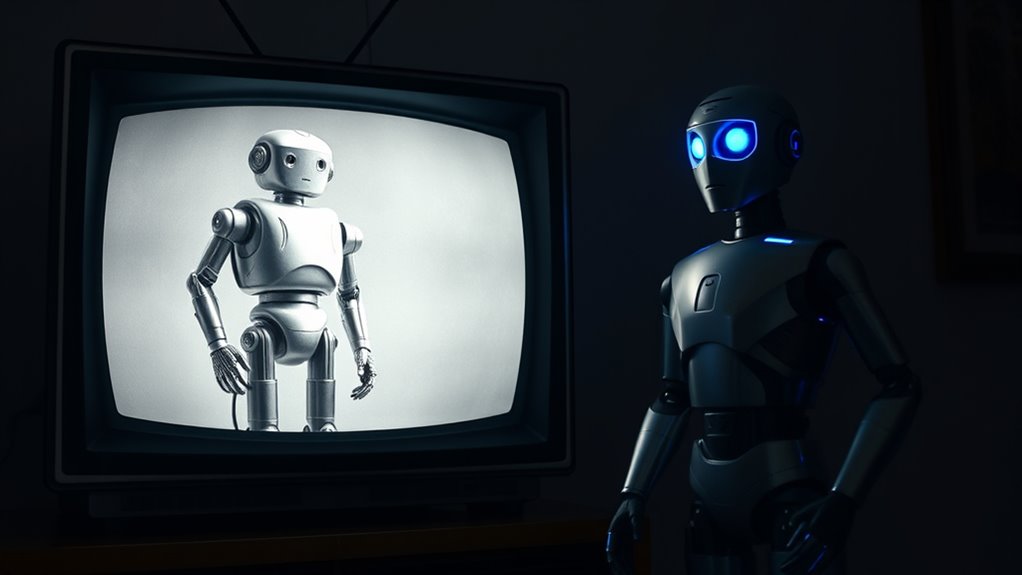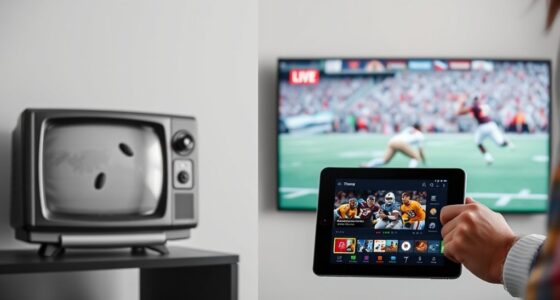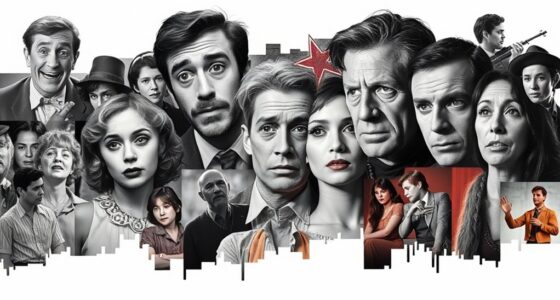TV shows shape how you see robots, from the early androids like “Lost in Space” to modern AI characters with complex emotions. You’ve likely noticed how these shows portray robots as helpful helpers or dangerous threats, influencing your expectations about real robots. While some stereotypes persist, today’s portrayals challenge those ideas with more nuanced characters. If you keep exploring, you’ll discover how these portrayals impact your understanding of real-world robotics and artificial intelligence.
Key Takeaways
- Early TV robots, like those in “Lost in Space” and “The Jetsons,” depicted subservient beings reinforcing stereotypes of automation and control.
- Classic portrayals often showed robots as either comic helpers or threatening villains, shaping public perceptions.
- Modern AI characters challenge stereotypes by portraying robots with emotional depth, moral dilemmas, and complex personalities.
- TV influences perceptions of robotics capabilities, blurring fiction and reality, and fueling expectations for human-like behavior.
- Stereotypes from TV shows impact human-robot interaction expectations, affecting trust, skepticism, and understanding of real-world robotics.

Have robots ever captured your imagination like they do on television? From the earliest days of sci-fi, you’ve been drawn into stories where machines mimic human behavior, sparking both wonder and concern. TV shows have played a significant role in shaping your perceptions of robots, especially through their portrayal of human-robot interaction. In many classic series, robots are depicted as either perfect servants or dangerous threats, reinforcing familiar stereotypes about what robots are or should be. These portrayals often simplify complex ideas, making you think of robots as either your loyal helpers or as beings to fear.
When you watch these shows, you notice that many robots are given human-like qualities—emotional expressions, speech, even consciousness. This creates a sense of relatability, making it easier for you to connect with the characters on screen. But it also feeds into certain stereotypes, like the idea that robots are inherently subservient or that they could someday turn against humans. These portrayals influence your understanding of human robot interaction, sometimes making you skeptical about the technology or overly optimistic about its potential. TV often blurs the lines between reality and fiction, leading you to believe that robots will soon behave like humans or that they’re destined to replace human roles entirely.
In the early days of television, robot characters often embodied stereotypes rooted in fears of automation and loss of control. Think about the iconic robots from shows like “Lost in Space” or “The Jetsons,” where robots served as comic relief or helpful assistants. These characters reinforced the stereotype that robots are here to serve humans, but they also hinted at concerns about losing autonomy. As technology advanced, so did the portrayals. Modern TV shows feature AI characters that challenge old stereotypes, showcasing robots with nuanced personalities, moral dilemmas, and even emotional depth. Yet, even in these sophisticated portrayals, echoes of the old stereotypes linger, influencing how you perceive real-world robotics and AI. Recognizing the color accuracy of these portrayals helps you distinguish between entertainment and the complex realities of current robotics technology.
Frequently Asked Questions
How Have Robot Portrayals Influenced Real-World Robotics Development?
Your exposure to TV robot portrayals has shaped how real-world robotics develop, especially in human robot interaction and AI character design. You see friendly, relatable robots on screen, which encourages engineers to create robots that are more approachable and effective in social settings. These portrayals push innovation, inspiring new technologies and design principles that make robots more intuitive, ultimately bridging the gap between entertainment and practical, everyday use.
What Are the Ethical Considerations of AI Characters on Television?
Have you ever wondered if AI characters on TV cross ethical lines? You should consider privacy concerns, as these characters often gather data or influence viewers’ emotions. Emotional manipulation becomes a risk if viewers develop attachments or trust without understanding the artificial nature. You need to question how these portrayals shape perceptions of AI and what responsibilities creators have to avoid misleading or exploiting audiences.
How Accurate Are TV Robots Compared to Real Robots Today?
TV robots today are often only partially accurate, with simplified robot design and exaggerated AI personalities for entertainment. You’ll notice they rarely reflect the complex hardware and advanced AI capabilities of real robots, which involve sophisticated sensors and learning algorithms. While TV robots look futuristic, their design and AI personality tend to be idealized, making them less accurate representations of what real robots can do today.
Which TV Robot Character Has the Most Cultural Impact?
You’ll find that Data from Star Trek: The Next Generation has the most cultural impact. His complex character development challenged robot stereotypes, showing that robots can possess emotions and morality. This portrayal influences how society views AI, moving beyond simple machines to characters with depth. Data’s story encourages viewers to see robots as potential companions and moral entities, shaping ongoing conversations about AI’s role in our future.
How Do TV Robots Reflect Societal Fears About Technology?
You see TV robots often embody societal fears about technology, reflecting cybernetic paranoia and technological anxiety. They symbolize concerns over losing control, ethical dilemmas, and the potential dangers of artificial intelligence. These characters serve as cautionary tales, making you ponder how far technology should advance. By dramatizing these fears, TV robots mirror real-world anxieties, prompting viewers to consider the ethical and societal impacts of rapid technological progress.
Conclusion
As you watch these robots evolve on TV, it’s funny how the earliest androids and today’s AI characters seem to mirror each other’s journeys. Sometimes, it’s almost like fate that the same questions—what it means to be human—keep surfacing. Maybe, just maybe, these stories aren’t random; they’re a coincidence guiding us to understand ourselves better through the robots we create and love. After all, isn’t that what storytelling’s all about?










